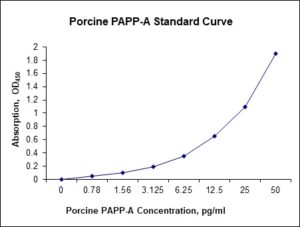Nori Porcine PAPP-A ELISA Kit
$461.00 – $832.00
This ELISA kit is for quantification of PAPP-A in pig. This is a quick ELISA assay that reduces time to 50% compared to the conventional method, and the entire assay only takes 3 hours. This assay employs the quantitative sandwich enzyme immunoassay technique and uses biotin-streptavidin chemistry to improve the performance of the assays. An antibody specific for PAPP-A has been pre-coated onto a microplate. Standards and samples are pipetted into the wells and any PAPP-A present is bound by the immobilized antibody. After washing away any unbound substances, a detection antibody specific for PAPP-A is added to the wells. Following wash to remove any unbound antibody reagent, a detection reagent is added. After intensive wash a substrate solution is added to the wells and color develops in proportion to the amount of PAPP-A bound in the initial step. The color development is stopped, and the intensity of the color is measured.
Alternative names for PAPP-A: Pappalysin-1, pregnancy-associated plasma protein
This product is for Laboratory Research Use Only not for diagnostic and therapeutic purposes or any other purposes.
- Description
- How Elisa Works
- Product Citation (0)
- Reviews (0)
Description
Nori Porcine PAPP-A ELISA Kit Summary
Alternative names for PAPP-A: Pappalysin-1, pregnancy-associated plasma protein, PAPPA
Alternative names for Porcine: pig, swine
| Assay Type | Solid Phase Sandwich ELISA |
| Format | 96-well Microplate or 96-Well Strip Microplate |
| Method of Detection | Colorimetric |
| Number of Targets Detected | 1 |
| Target Antigen Accession Number | F1SMI4 |
| Assay Length | 3 hours |
| Quantitative/Semiquantitative | Quantitative |
| Sample Type | Plasma, Serum, Cell Culture, Urine, Cell/Tissue Lysates, Synovial Fluid, BAL, |
| Recommended Sample Dilution (Plasma/Serum) | No dilution for sample <ULOQ; sufficient dilution for samples >ULOQ |
| Sensitivity | 150 pg/mL |
| Detection Range | 0.78-50 ng/mL |
| Specificity | Porcine PAPP-A |
| Cross-Reactivity | < 0.5% cross-reactivity observed with available related molecules, < 50% cross-species reactivity observed with species tested. |
| Interference | No significant interference observed with available related molecules |
| Storage/Stability | 4 ºC for up to 6 months |
| Usage | For Laboratory Research Use Only. Not for diagnostic or therapeutic use. |
| Additional Notes | The kit allows for use in multiple experiments. |
Standard Curve
Kit Components
1. Pre-coated 96-well Microplate
2. Biotinylated Detection Antibody
3. Streptavidin-HRP Conjugate
4. Lyophilized Standards
5. TMB One-Step Substrate
6. Stop Solution
7. 20 x PBS
8. Assay Buffer
Other Materials Required but not Provided:
1. Microplate Reader capable of measuring absorption at 450 nm
2. Log-log graph paper or computer and software for ELISA data analysis
3. Precision pipettes (1-1000 µl)
4. Multi-channel pipettes (300 µl)
5. Distilled or deionized water
Protocol Outline
1. Prepare all reagents, samples and standards as instructed in the datasheet.
2. Add 100 µl of Standard or samples to each well and incubate 1 h at RT.
3. Add 100 µl of Working Detection Antibody to each well and incubate 1 h at RT.
4. Add 100 µl of Working Streptavidin-HRP to each well and incubate 20 min at RT.
5. Add 100 µl of Substrate to each well and incubate 5-30 min at RT.
6. Add 50 µl of Stop Solution to each well and read at 450 nm immediately.
Background:
Pappalysin-1, also known as pregnancy-associated plasma protein A, is a protein encoded by the PAPPA gene in humans.[1,2] PAPPA is a secreted protease whose main substrate is insulin-like growth factor binding proteins (IGFBPs).[3] Pappalysin-1 is also used in screening tests for Down syndrome.[4] PAPPA’s proteolytic function is activated upon collagen binding. It is thought to be involved in local proliferative processes such as wound healing and bone remodeling. Low plasma level of this protein has been suggested as a biochemical marker for pregnancies with aneuploid fetuses. For example, low PAPPA may be commonly seen in prenatal screening for Down syndrome.[4] Low levels may alternatively predict issues with the placenta, resulting in adverse complications such as intrauterine growth restriction, preeclampsia, placental abruption, premature birth, or fetal death. PAPP-A has been shown to interact with major basic protein[2][4] and specifically inhibits the third component of human complement (C3).[6] PAPP-A interacts with serine proteinases.[7] In STEMI patients, Stanniocalcin-2 and IGFBP-4 emerged as independent predictors of all-cause death and readmission due to HF. The Stanniocalcin-2/PAPP-A/IGFBP-4 axis exhibits a significant role in STEMI risk stratification.[8]
References
- Kristensen T, et al. (1994). Biochemistry. 33 (6): 1592–8.
- Overgaard MT, et al. (2000) J. Biol. Chem. 275 (40): 31128–33.
- Durham SK, et al. (1994). J. Bone Miner. Res. 9 (1): 111–7.
- Breathnach FM, Malone FD (2007). Curr. Opin. Obstet. Gynecol. 19 (2): 176–82.
- Overgaard MT, et al. (2003) J. Biol. Chem. 278 (4): 2106–17.
- Bischof P, et al. (1984). Placenta. 5 (1): 1–7.
- Zorin NA, et al. (1995). Clin. Chim. Acta. 239 (1): 47–55.
8. Cediel G, et al. (2018) Cardiovasc Diabetol 17 (1), 63
Be the first to review “Nori Porcine PAPP-A ELISA Kit”
You must be logged in to post a review.




























Reviews
There are no reviews yet.